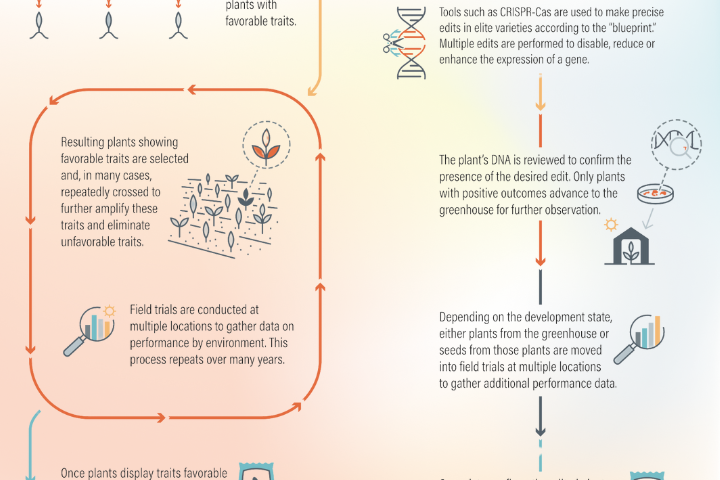Why Multiplex Gene Editing is Key for Adapting to a Fast-Changing Climate
–
Plant breeding is not revolutionary. Actually, it’s quite the opposite: Humans have harnessed the art and science of breeding for more than 12,000 years to produce plants based on what they found most beneficial.
Dating back to the beginning of agriculture, ancestral farmers selected plants based on the characteristics they liked. That eventually led to plant breeding: crossing plants to introduce preferred genetic traits from one variety to another. Humans have continued to do this ever since, working to adjust plants by combining favorable characteristics and eliminating those deemed unfavorable.
As the fruitful future of our population and planet hangs in the balance, we ask ourselves: How can we ensure breeding serves us for the next 12,000 years?
Early Breakthroughs in Breeding
Plant selection efforts were greatly improved by scientific knowledge as breeders began to incorporate more sophisticated genetic tools into their work, an approach perhaps best highlighted by the astonishing success of breeder Norman Borlaug to increase wheat yields by 70%.
Borlaug contributed to what is referred to as the “Green Revolution.” His improved genetic methods to increase yield helped Mexico and India meet production demands, withstand harsh climates and ultimately become agriculturally self-sufficient.
These technological advancements in agriculture helped alleviate world hunger and earned Borlaug the 1970 Nobel Peace Prize.
Gene Editing for a Nature-Positive World
Today, the convergence of A.I., genomics and gene editing are propelling the next wave of breeding advancements.
Using tools such as CRISPR, breeders and plant scientists can now “cut” a specific DNA sequence, then rely on the cells’ natural DNA repair mechanisms to introduce changes at that site. This technology edits a living organism’s DNA similar to how a word processor edits written documents – adding, deleting and replacing letters in the cell’s natural genetic code. The resulting outcomes are just like those of traditional breeding, but accomplished in far less time, with much greater precision and far fewer resources.
Editing just a single gene can have a noticeable effect, especially true in nutrition. We are seeing tomatoes with higher levels of amino acids thought to reduce blood pressure and soybean oil with fewer saturated fatty acids.
Single edits are not, however, able to alleviate some of the world’s biggest challenges which calls for increasing yield with a reduced use of natural resources. For that, we need multiplex gene editing. Multiplex gene editing, an advanced form of gene editing in which multiple edits are made to multiple genes at the same time, represents a crucial leap forward in the 12,000-year history of breeding. It’s no understatement to say it has the potential to meaningfully change how plants grow and use resources.
The potential of multiplex gene editing is significant: At Inari, we are using this technology with the aim of increasing yields by 10-20% in corn, soybeans and wheat – up to 20 times the current industry average. In addition, we are working to reduce corn’s need for nitrogen fertilizer and water by 40% without sacrificing productivity, something no previous breeding method can accomplish in a reasonable time given the urgency we are facing.
These are benefits with lasting, positive ripple effects on our ecosystem. When we can improve crops’ overall resource use efficiency, farmers can make more sustainable and strategic decisions about how they use land and resources. Just think: If we could meet global demand for soybeans using even 10% less land, how else could we use that land? From conservation to growing alternative crops – it provides farmers with new options on how to use their land.
Where Can Gene Editing Take Us from Here?
Nature needs our help. When we breed faster and with more precision, results that would otherwise take 15 years can be achieved in just four to five years.
Think of the small grass plant teosinte, which was domesticated and bred into what we know today as corn – one of the most widely recognized global commodities. Or, the healthful staples such as brussels sprouts, cauliflower, broccoli and kale, which were all derived from the same wild mustard plant before humans selectively bred them to amplify certain traits. Without any human intervention, this likely would not have been possible. And with gene editing technology, we will be able to accomplish similar endeavors in a much shorter period of time.
The world is changing too fast for 20th century breeding to remain slow. We don’t have a choice but to try and adapt with climate change. Extreme weather events and unexpected shocks and stresses continuously expose the vulnerabilities of our food system, which is why we need tools to get ahead of whatever Mother Nature brings, without delay.
We aren’t alone in recognizing this potential. Farmers around the globe are pleading for access to new plant breeding tools like gene editing to survive. We also won’t accomplish this alone; there is a great deal of work and collaboration to be done.
So, we must ask ourselves, what are we waiting for? We don’t have the option to slow down when we only have one lifetime – this lifetime – to build a more sustainable global food system. The good news is, multiplex gene editing is providing us with a unique opportunity to keep pace with our fast-changing climate and provide for generations to come.
The path is clear. Now we just need to follow it.
RELATED POSTS
Q&A: An Insider’s Insights on Gene Editing
Gro Alliance’s Jim Schweigert shares why the technology is a pathway to a fruitful future New breeding technologies like gene editing come with a multitude of benefits. Agriculture leaders recognize…
An 80-Year-Old Lesson for Addressing Climate Change
By Jamie SaxonHead of Sustainability – Earth Day is typically spent reflecting on how to support a better future, but today, I want to start by looking back – specifically, 80…
Infographic: Accelerating Breeding for a Fast-Changing Future
Humans have been breeding plants to their benefit for thousands of years. And while this has opened incredible frontiers in agriculture, traditional breeding practices remain gradual and labor-intensive. Given today’s…


